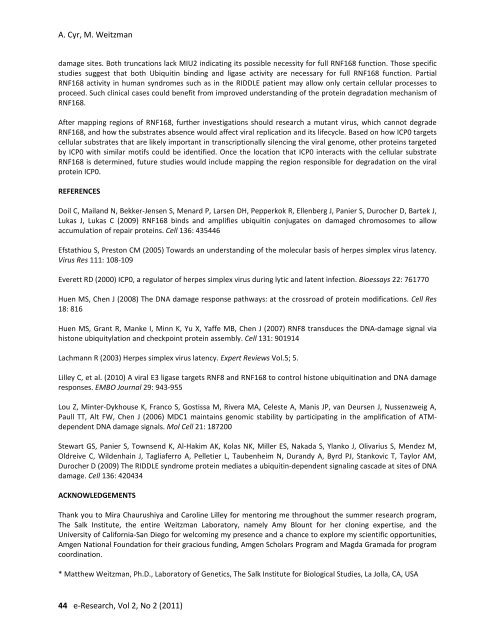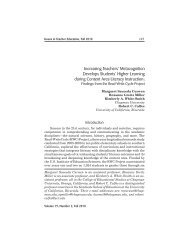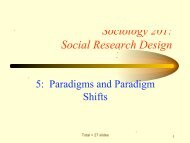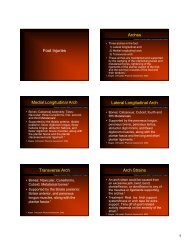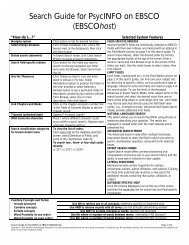e-Research: A Journal of Undergraduate Work - Chapman University
e-Research: A Journal of Undergraduate Work - Chapman University
e-Research: A Journal of Undergraduate Work - Chapman University
You also want an ePaper? Increase the reach of your titles
YUMPU automatically turns print PDFs into web optimized ePapers that Google loves.
A. Cyr, M. Weitzman<br />
damage sites. Both truncations lack MIU2 indicating its possible necessity for full RNF168 function. Those specific<br />
studies suggest that both Ubiquitin binding and ligase activity are necessary for full RNF168 function. Partial<br />
RNF168 activity in human syndromes such as in the RIDDLE patient may allow only certain cellular processes to<br />
proceed. Such clinical cases could benefit from improved understanding <strong>of</strong> the protein degradation mechanism <strong>of</strong><br />
RNF168.<br />
After mapping regions <strong>of</strong> RNF168, further investigations should research a mutant virus, which cannot degrade<br />
RNF168, and how the substrates absence would affect viral replication and its lifecycle. Based on how ICP0 targets<br />
cellular substrates that are likely important in transcriptionally silencing the viral genome, other proteins targeted<br />
by ICP0 with similar motifs could be identified. Once the location that ICP0 interacts with the cellular substrate<br />
RNF168 is determined, future studies would include mapping the region responsible for degradation on the viral<br />
protein ICP0.<br />
REFERENCES<br />
Doil C, Mailand N, Bekker-Jensen S, Menard P, Larsen DH, Pepperkok R, Ellenberg J, Panier S, Durocher D, Bartek J,<br />
Lukas J, Lukas C (2009) RNF168 binds and amplifies ubiquitin conjugates on damaged chromosomes to allow<br />
accumulation <strong>of</strong> repair proteins. Cell 136: 435446<br />
Efstathiou S, Preston CM (2005) Towards an understanding <strong>of</strong> the molecular basis <strong>of</strong> herpes simplex virus latency.<br />
Virus Res 111: 108-109<br />
Everett RD (2000) ICP0, a regulator <strong>of</strong> herpes simplex virus during lytic and latent infection. Bioessays 22: 761770<br />
Huen MS, Chen J (2008) The DNA damage response pathways: at the crossroad <strong>of</strong> protein modifications. Cell Res<br />
18: 816<br />
Huen MS, Grant R, Manke I, Minn K, Yu X, Yaffe MB, Chen J (2007) RNF8 transduces the DNA-damage signal via<br />
histone ubiquitylation and checkpoint protein assembly. Cell 131: 901914<br />
Lachmann R (2003) Herpes simplex virus latency. Expert Reviews Vol.5; 5.<br />
Lilley C, et al. (2010) A viral E3 ligase targets RNF8 and RNF168 to control histone ubiquitination and DNA damage<br />
responses. EMBO <strong>Journal</strong> 29: 943-955<br />
Lou Z, Minter-Dykhouse K, Franco S, Gostissa M, Rivera MA, Celeste A, Manis JP, van Deursen J, Nussenzweig A,<br />
Paull TT, Alt FW, Chen J (2006) MDC1 maintains genomic stability by participating in the amplification <strong>of</strong> ATMdependent<br />
DNA damage signals. Mol Cell 21: 187200<br />
Stewart GS, Panier S, Townsend K, Al-Hakim AK, Kolas NK, Miller ES, Nakada S, Ylanko J, Olivarius S, Mendez M,<br />
Oldreive C, Wildenhain J, Tagliaferro A, Pelletier L, Taubenheim N, Durandy A, Byrd PJ, Stankovic T, Taylor AM,<br />
Durocher D (2009) The RIDDLE syndrome protein mediates a ubiquitin-dependent signaling cascade at sites <strong>of</strong> DNA<br />
damage. Cell 136: 420434<br />
ACKNOWLEDGEMENTS<br />
Thank you to Mira Chaurushiya and Caroline Lilley for mentoring me throughout the summer research program,<br />
The Salk Institute, the entire Weitzman Laboratory, namely Amy Blount for her cloning expertise, and the<br />
<strong>University</strong> <strong>of</strong> California-San Diego for welcoming my presence and a chance to explore my scientific opportunities,<br />
Amgen National Foundation for their gracious funding, Amgen Scholars Program and Magda Gramada for program<br />
coordination.<br />
* Matthew Weitzman, Ph.D., Laboratory <strong>of</strong> Genetics, The Salk Institute for Biological Studies, La Jolla, CA, USA<br />
44 e-<strong>Research</strong>, Vol 2, No 2 (2011)


